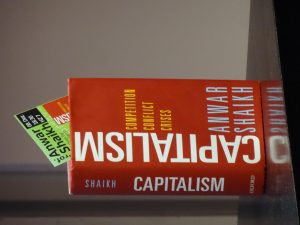Perils of Exchange Rate Mis-Alignment
✑ ASAD ZAMAN` ╱ ± 5 minutes


The Government of Pakistan subsidizes imports of luxuries for the elites by spending billions in foreign exchange to keep the price of the dollar low, which also harms the domestic economy. On the Dutch Disease in Pakistan.

When the subsidy is withdrawn, there will be a lot of rich and powerful losers.

The Government of Pakistan subsidizes imports of luxuries for the elites by spending billions in foreign exchange to keep the price of the dollar low, which also harms the domestic economy. On the Dutch Disease in Pakistan.
From: WEA Pedagogy Blog, Jan 24, 2019. ╱ About the author
Asad Zaman is an economist, professor and social scientist from Pakistan. He is currently Vice Chancellor of the Pakistan Institute of Development Economics, Islamabad. He has a Ph.D. in economics from Stanford University (1978) and has taught in Economics Departments at U. Penn., Columbia Univ., Johns Hopkins, Cal. Tech, Bilkent Univ, Ankara, and LUMS, Lahore. Visit his personal website and read his articles on the WEA Pedagogy Blog.
| Published as “Burning Billions” in Dawn, on 18th Jan 2019. |
|---|
As I have only recently come to realize, stabilizing the exchange rate at the wrong level can have massively harmful effects. One can trace major economic tragedies to such attempts. The British attempt to go back to the gold standard after post WW1 failed because they set the level too high (as Keynes pointed out). This attempt set of a sequence of events which had far reaching consequences. A similar story is told about Pakistan in “The Rupee is falling; let it crash”. Linked article shows that overvaluation of Pak Rupee de-linked the Pakistan and Indian Economies, which may the economic root of current political hostilities. Current problems of the European Union are a more advanced version of the same problem, where the rate of exchange between European countries cannot be re-aligned according to the gaps between their imports and exports. This is a subject worth exploring further, and if readers have more pointers/articles, I would appreciate learning more about it. The article below deals with the Dutch Disease in Pakistan.
Today, we can find, fairly cheaply, an amazing variety of imports from all over the world in Pakistan: honey from Germany, vegetables from Brazil, milk from Australia, and clothing from India. The Government of Pakistan subsidizes imports of luxuries for the elites by spending billions in foreign exchange to keep the price of the dollar low. Many different economic indicators show a pattern of consistent and maintained overvaluation of the Rupee over the past several decades. In contrast, many competitors who started out behind us, like India, Bangladesh, and China, have surpassed us in exports by keeping their currencies consistently under-valued.
The proxy war between US and Russia in Afghanistan made massive amounts of dollars available to Pakistan, creating favorable conditions for the Dutch disease. Remittances have also been a significant source of easy foreign exchange earnings. We did not have the wise leadership required to use the availability of foreign exchange to build productive capacity in the domestic economy. Instead, we fell into the trap of building a consumer-oriented economy based on cheap imports, which is attractive in the short-run, but enormously costly in the long run.
An agricultural country imports $6 Billion worth of agricultural products, like food, raw cotton, edible oil, only because over-valuation makes it cheaper to import than to produce. The government must burn billions of dollars to maintain an over-valued rupee, enabling the wealthy to enjoy foreign luxuries. Unfortunately, the standard sources from which we used to borrow to finance our spending spree have dried up.
However, there are many obstacles in the path. When the subsidy of billions of dollars for imports is withdrawn, there will be a lot of rich and powerful losers. They will demand continuation of the previous policies which created huge profits for them. The potential beneficiaries of the structural change are as yet unborn, and therefore cannot speak in favor of the change.
The challenge facing the current government is to manage the transition in a way which would minimize disturbances to the masses, and provide social support to those who need it the most. The greatest dangers come from the privileged classes, accustomed to extracting revenues without having to work. The billions pumped into supporting the rupees end up, indirectly, in their pockets. Withdrawing this subsidy will lead to loud screams by the rich and powerful, disguised to sound as if they are coming from the people. Whether the government has the courage to stay the course remains to be seen.
Today, we can find, fairly cheaply, an amazing variety of imports from all over the world in Pakistan: honey from Germany, vegetables from Brazil, milk from Australia, and clothing from India. The Government of Pakistan subsidizes imports of luxuries for the elites by spending billions in foreign exchange to keep the price of the dollar low. Many different economic indicators show a pattern of consistent and maintained overvaluation of the Rupee over the past several decades. In contrast, many competitors who started out behind us, like India, Bangladesh, and China, have surpassed us in exports by keeping their currencies consistently under-valued.
The Government of Pakistan subsidizes imports of luxuries for the elites by spending billions in foreign exchange to keep the price of the dollar low.Long term cheap availability of imports has a well-known effect called the “Dutch Disease”. Normally, the Dutch Disease strikes countries which are rich in resources (like oil). This makes it possible for them to earn foreign exchange cheaply, without learning how to manufacture world class exports. When the exchange rate is too low, imports are cheap, and prevent the development of local industry. At the same time, exports decline because they are too expensive on the world market. Services sector enjoys a boom because services are locally produced and have no cheap foreign imports to compete with. Over the past few decades, the Pakistan economy shows all the characteristic symptoms of Dutch disease, with deindustrialization, declining exports, increasing imports, and a boom in the service sector.
The proxy war between US and Russia in Afghanistan made massive amounts of dollars available to Pakistan, creating favorable conditions for the Dutch disease. Remittances have also been a significant source of easy foreign exchange earnings. We did not have the wise leadership required to use the availability of foreign exchange to build productive capacity in the domestic economy. Instead, we fell into the trap of building a consumer-oriented economy based on cheap imports, which is attractive in the short-run, but enormously costly in the long run.
An agricultural country imports $6 Billion worth of agricultural products, like food, raw cotton, edible oil, only because over-valuation makes it cheaper to import than to produce. The government must burn billions of dollars to maintain an over-valued rupee, enabling the wealthy to enjoy foreign luxuries. Unfortunately, the standard sources from which we used to borrow to finance our spending spree have dried up.
If the exchange rate was higher, people would demand domestic products.The future is in our hands. We can continue to borrow, from other sources, and maintain an economy driven by consumption, and by industries which make profits by using artificially cheap imports. Or we can bite the bullet and go for the structural transformation required to create productivity in the domestic economy, which is the only route to long run sustainable growth. But there are serious obstacles in the path of the needed structural transformation. Currently, when we pump money into the domestic economy, it is channeled into imports because dollars are cheap. If the exchange rate was higher, people would demand domestic products. However, currently, those domestic products do not exist. The industries which could have come into existence had imports been expensive were never born. There is no domestic capacity to fulfill the additional demand, if it is blocked from going into foreign imports. Thus, increased aggregate demand for domestic products will only lead to inflation – increased prices of domestic goods in the desirable sectors. Contrary to common belief, this type of inflation is not harmful. In fact, high prices are required to send a signal to the domestic sectors that extra production is desirable and will be profitable. If we can sustain the policy of keeping aggregate demand in domestic products high, higher prices in the desired sectors will lead to creation of extra productive capacity and stimulate domestic industry, which is exactly what is needed.
However, there are many obstacles in the path. When the subsidy of billions of dollars for imports is withdrawn, there will be a lot of rich and powerful losers. They will demand continuation of the previous policies which created huge profits for them. The potential beneficiaries of the structural change are as yet unborn, and therefore cannot speak in favor of the change.
The challenge facing the current government is to manage the transition in a way which would minimize disturbances to the masses, and provide social support to those who need it the most. The greatest dangers come from the privileged classes, accustomed to extracting revenues without having to work. The billions pumped into supporting the rupees end up, indirectly, in their pockets. Withdrawing this subsidy will lead to loud screams by the rich and powerful, disguised to sound as if they are coming from the people. Whether the government has the courage to stay the course remains to be seen.
| Top image: Exchange rate US Dollar / Pak Rupee. From: Yahoo Finance |
|---|






















Comments
Post a Comment
Your thoughts...